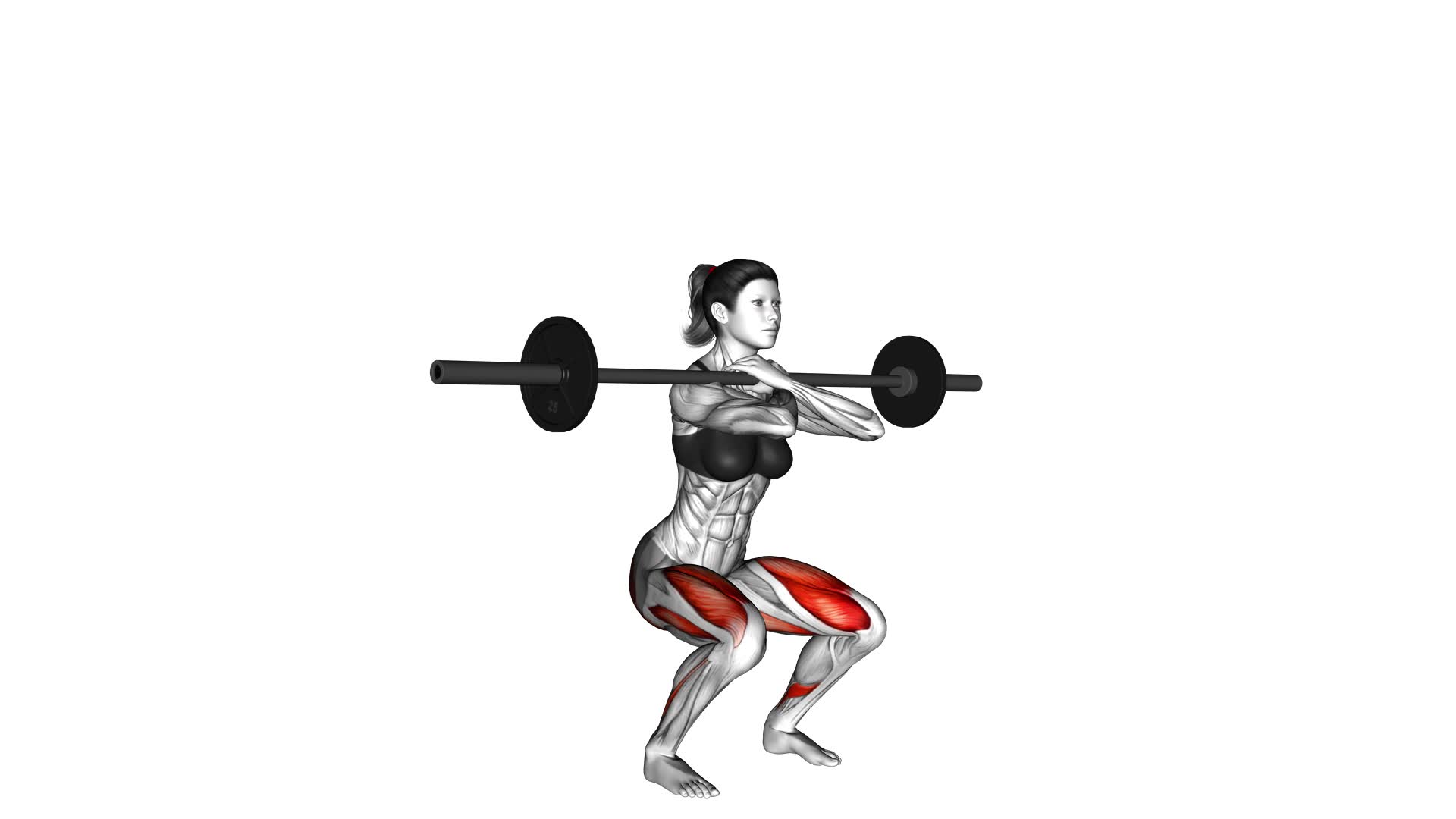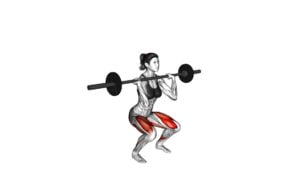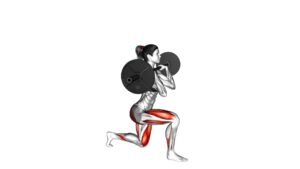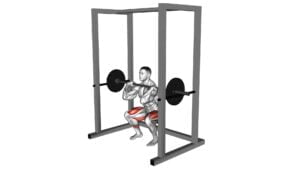Barbell Front Squat (female) – Video Exercise Guide & Tips

Looking to strengthen your lower body and improve your overall fitness? The barbell front squat is a great exercise for women like you.
Watch This Exercise Video
In this video exercise guide, we'll show you the proper set-up and equipment needed, as well as a step-by-step guide to performing the exercise.
We'll also cover common mistakes to avoid and provide tips for increasing the intensity.
Stay safe and get ready to feel the burn with the barbell front squat!
Key Takeaways
- Barbell front squats can lead to significant strength gains and improved lower body muscle definition for women.
- This exercise engages multiple muscle groups simultaneously and enhances core strength.
- Proper form and balance are essential, and maintaining proper weight distribution is crucial.
- Experimenting with elbow positioning, increasing intensity over time, and incorporating advanced techniques can maximize the benefits of barbell front squats for women.
Benefits of Barbell Front Squat for Women
You will experience significant strength gains and improved lower body muscle definition when incorporating barbell front squats into your workout routine. The barbell front squat is an excellent exercise for women looking to improve their core strength and activate multiple muscle groups simultaneously.
One of the main benefits of the barbell front squat is its ability to improve core strength. By holding the barbell in front of your body, you're forced to engage your abdominal muscles to maintain proper form and balance. This not only strengthens your core muscles but also helps to stabilize your spine during the movement.
Additionally, the barbell front squat activates several muscle groups in the lower body. As you lower yourself into the squat position, your quadriceps, hamstrings, and glutes are all engaged to support the weight. This leads to increased muscle activation and ultimately, improved muscle definition in these areas.
Incorporating barbell front squats into your workout routine can also help to enhance overall lower body strength. By challenging your muscles with heavier weights, you can stimulate muscle growth and increase your overall strength levels.
To maximize the benefits of barbell front squats, it's essential to maintain proper form and gradually increase the weight. Begin with lighter weights and focus on mastering the technique before progressing to heavier loads. Remember to always consult with a qualified fitness professional before starting any new exercise program.
Proper Set-Up and Equipment for Barbell Front Squat
To properly set up for the barbell front squat and ensure effective execution, it's important to have the right equipment and follow a few key steps.
The equipment needed for front squats includes a barbell, weight plates, and a squat rack. Make sure the barbell is positioned at shoulder height on the rack, and adjust the J-hooks if necessary. Place the desired weight plates on each side of the barbell, ensuring they're secure and evenly distributed.
To perform the front squat, stand facing the barbell and grip it with your hands slightly wider than shoulder-width apart. Carefully lift the barbell off the rack and step back, maintaining an upright posture.
Position the barbell across the front of your shoulders, resting it on your clavicles and using your fingertips to lightly support it. Throughout the exercise, keep your core engaged and maintain good posture.
Remember to modify the front squat as needed based on your fitness level and any physical limitations. With the proper equipment and technique, you can safely and effectively perform the barbell front squat.
Step-by-Step Guide to Performing the Barbell Front Squat
To begin the barbell front squat, grab the barbell with a slightly wider than shoulder-width grip and carefully lift it off the rack. Make sure your elbows are high, with your upper arms parallel to the ground. Step back and position your feet shoulder-width apart, with your toes slightly turned out. Keep your chest up and maintain a straight back throughout the exercise.
Now, let's go through the step-by-step guide to performing the barbell front squat:
- Take a deep breath and brace your core.
- Initiate the movement by bending at the knees and hips, lowering your body towards the ground.
- Keep your weight on your heels and your knees tracking over your toes.
- Squat down until your thighs are parallel to the ground, or slightly below if you have the flexibility.
- Drive through your heels and push your hips forward to return to the starting position.
Common Mistakes to Avoid During Barbell Front Squat
When performing the barbell front squat, it's important to pay attention to your weight distribution. Make sure to keep your weight evenly distributed between your heels and the balls of your feet to maintain balance and stability.
Additionally, pay attention to your elbow positioning. Keep your elbows up and parallel to the ground to prevent the barbell from rolling forward and putting unnecessary strain on your wrists.
Weight Distribution Tips
You often make the mistake of uneven weight distribution during the barbell front squat. Proper weight distribution is crucial for maintaining balance and stability during this exercise. Here are some weight distribution techniques to help you avoid common mistakes:
- Ensure that your weight is evenly distributed between both feet.
- Keep your heels grounded throughout the movement to maintain stability.
- Avoid shifting your weight forward onto your toes or backward onto your heels.
- Engage your core muscles to help support your body and maintain proper weight distribution.
By following these weight distribution techniques, you can improve your form and maximize the benefits of the barbell front squat.
Now let's move on to the next section about elbow positioning techniques.
Elbow Positioning Techniques
Maintain proper elbow positioning to avoid common mistakes during the barbell front squat, ensuring balance and stability throughout the exercise. Improper elbow positioning can lead to discomfort and decreased effectiveness of the exercise.
One common mistake is allowing the elbows to drop, causing the weight to shift forward and placing excessive stress on the wrists. To avoid this, keep the elbows high and in line with the shoulders throughout the movement.
Another mistake is gripping the bar too tightly, which can restrict mobility and hinder proper form. Instead, maintain a firm but relaxed grip to allow for fluid movement.
Additionally, some individuals may need to make elbow positioning modifications based on their flexibility and mobility. Experiment with different hand and arm positions to find what feels most comfortable and allows for proper alignment.
Tips for Increasing the Intensity of Barbell Front Squat
To increase the intensity of your barbell front squat, there are a few key technique refinements you can focus on.
First, make sure you're maintaining proper form throughout the movement, keeping your core engaged and your back straight.
Additionally, you can implement progressive overload strategies by gradually increasing the weight or reps over time.
Technique Refinements for Gains
To increase the intensity of the Barbell Front Squat, incorporate these technique refinements for optimal gains:
- Focus on squat depth: Aim to squat low enough so that your thighs are parallel to the floor. This will engage your leg muscles more effectively and increase the difficulty of the exercise.
- Use proper breathing techniques: Inhale deeply before descending into the squat and exhale forcefully as you push back up. This will help stabilize your core and provide additional power during the movement.
- Maintain an upright torso: Keep your chest up and your back straight throughout the squat. This will ensure proper form and prevent unnecessary strain on your lower back.
- Control the descent and ascent: Avoid using momentum to power through the movement. Instead, lower yourself down slowly and push back up in a controlled manner. This will increase the time under tension and maximize muscle activation.
Progressive Overload Strategies
To further increase the intensity of your Barbell Front Squat, it's important to implement progressive overload strategies that challenge your muscles and promote continued gains.
Overload progression involves gradually increasing the weight you lift over time. This can be done by adding small increments of weight each week or increasing the number of sets and reps you perform.
Another strategy is to decrease the rest periods between sets, forcing your muscles to work harder. Additionally, you can incorporate techniques like drop sets or supersets to push your muscles to their limits.
These strategies help stimulate training adaptations, such as increased muscle strength and size. By consistently challenging your muscles with progressive overload, you can continue to make progress in your Barbell Front Squat.
Now, let's explore another way to enhance the effectiveness of this exercise by utilizing tempo variations.
Utilizing Tempo Variations
Implementing tempo variations can be an effective way to increase the intensity of your Barbell Front Squat and further challenge your muscles. By manipulating the speed at which you perform the exercise, you can target different muscle fibers and enhance muscle activation.
Here are some tempo variations you can try:
- Slow Eccentric: Lower the barbell down slowly, taking 3-4 seconds to descend. This increases time under tension and engages more muscle fibers.
- Explosive Concentric: Drive the barbell upward with maximum force, focusing on explosive power during the upward phase of the squat.
- Paused Reps: Pause at the bottom of the squat for 2-3 seconds before returning to the starting position. This increases the demand on your muscles and improves stability.
- Tempo Pyramid: Perform a set with a slow eccentric, followed by a set with an explosive concentric, and finish with a set of paused reps. This variation combines different tempos for maximum muscle activation.
Incorporating these tempo variations into your Barbell Front Squat routine can help you push your limits and achieve greater gains in strength and muscle development.
Safety Precautions and Modifications for Barbell Front Squat
When performing the Barbell Front Squat, it's important to prioritize safety by implementing proper form and making necessary modifications. Safety modifications are essential to prevent injuries and ensure a successful workout.
To begin, ensure that you have the proper setup and equipment. This includes using a squat rack or power rack to support the barbell and having a spotter nearby for added security.
It's also crucial to choose the appropriate weight for your fitness level and gradually increase it over time as you become more comfortable with the exercise.
In terms of form, make sure to keep your core engaged and your back straight throughout the movement. Maintain a shoulder-width stance and keep your knees in line with your toes as you lower into the squat.
If you have any existing knee or hip issues, consider using a knee sleeve or modifying the depth of the squat to reduce strain on these areas.
Remember to listen to your body, start with lighter weights, and gradually progress to heavier loads as your strength improves.
Frequently Asked Questions
How Many Sets and Reps Should I Do When Performing the Barbell Front Squat?
To maximize the benefits of the barbell front squat, it's important to determine the optimal sets and reps for your workout.
The number of sets and reps can vary depending on your fitness level and goals. Generally, starting with 3-4 sets of 8-12 reps is a good place to begin.
However, you can also experiment with different variations of the front squat exercise, such as using lighter weights for higher reps or heavier weights for lower reps, to challenge your muscles in different ways.
What Is the Recommended Weight to Use for the Barbell Front Squat?
When it comes to the recommended weight for the barbell front squat, it depends on your fitness level and goals. Start with a weight that challenges you but allows you to maintain proper form.
As you progress, gradually increase the weight to continue challenging yourself. Remember, there are variations of the front squat that can be done with lighter weights or even just bodyweight.
It's important to find the weight that works best for you and your specific needs.
Can I Substitute the Barbell With Dumbbells or Kettlebells for the Front Squat?
Yes, you can substitute the barbell with dumbbells or kettlebells for the front squat. Using dumbbells or kettlebells can provide a different challenge and engage your muscles in a slightly different way.
However, it's important to note that using a barbell offers certain benefits, such as allowing you to lift heavier weights and target specific muscle groups.
Ultimately, the choice of equipment depends on your preference and fitness goals.
How Often Should I Include the Barbell Front Squat in My Workout Routine?
To get the best results, it's important to know how to properly perform the barbell front squat. Incorporating this exercise into your routine can be beneficial for building strength and improving overall lower body development.
However, it's essential to avoid common mistakes that could lead to injury. Make sure to maintain proper form, keep your core engaged, and avoid leaning too far forward.
As for how often to include it in your workout routine, it depends on your goals and overall training plan.
Are There Any Specific Warm-Up Exercises or Stretches I Should Do Before Attempting the Barbell Front Squat?
Before attempting the barbell front squat, it's important to warm up properly. Incorporating dynamic stretches can help prepare your muscles for the exercise.
Try doing leg swings, hip circles, and walking lunges to increase mobility and flexibility. Additionally, using a foam roller on your quads, hamstrings, and glutes can help reduce muscle tension and improve range of motion.
Conclusion
In conclusion, the barbell front squat is a highly effective exercise for women, offering numerous benefits such as improved strength, balance, and muscle tone.
By following the proper set-up and technique, avoiding common mistakes, and implementing tips for increasing intensity, women can safely and effectively incorporate this exercise into their workouts.
Remember to prioritize safety and make any necessary modifications to accommodate individual fitness levels and abilities.

Author
Years ago, the spark of my life’s passion ignited in my mind the moment I stepped into the local gym for the first time. The inaugural bead of perspiration, the initial endeavor, the very first surge of endorphins, and a sense of pride that washed over me post-workout marked the beginning of my deep-seated interest in strength sports, fitness, and sports nutrition. This very curiosity blossomed rapidly into a profound fascination, propelling me to earn a Master’s degree in Physical Education from the Academy of Physical Education in Krakow, followed by a Sports Manager diploma from the Jagiellonian University. My journey of growth led me to gain more specialized qualifications, such as being a certified personal trainer with a focus on sports dietetics, a lifeguard, and an instructor for wellness and corrective gymnastics. Theoretical knowledge paired seamlessly with practical experience, reinforcing my belief that the transformation of individuals under my guidance was also a reflection of my personal growth. This belief holds true even today. Each day, I strive to push the boundaries and explore new realms. These realms gently elevate me to greater heights. The unique combination of passion for my field and the continuous quest for growth fuels my drive to break new ground.







